香港便览(城市规划)town_planning
香港便览 - 道路设施

香港便覽道路设施香港道路使用率之高,位居世界前列。
在全长2 094公里的道路上 — 其中港岛占442公里、九龙占465公里、新界占1 187公里,有逾69万部车辆行驶;加上楼宇密集、地势不平,为道路工程师带来持续不断的挑战。
本港目前有15条主要的行车隧道、1 327条行车天桥及桥梁、1 205条行人天桥及行人隧道,以保持客货流通。
港岛:港岛最早期的一条道路,是由中区绕过港岛西端通往香港仔。
其后,续有两条道路建成,其一越过港岛中部,另一则绕过其东端。
于1972年8月启用的海底隧道,将九龙半岛与港岛连接起来。
为配合港岛的迅速发展,沿薄扶林道西行的路线,已分期扩建成为四线行车道。
由于鸭脷洲南部不断发展,当局分别于1980年3月及1994年7月建成两条跨海桥,提供前往鸭脷洲的直接通道。
一号干线由南至北贯通港岛中部并连接香港仔、跑马地及海底隧道。
一号干线包括香港仔隧道及其两端出口处的分层道路系统,工程在1982年3月完成。
东区海底隧道于1989年9月建成,这条隧道连接九龙茶果岭与港岛鲗鱼涌。
港岛北岸有一条双程三线由中环至铜锣湾的道路,连接长九公里、双程三线并向东伸延至柴湾的东区走廊。
东区走廊于1981年年初动工兴建,在1989年10月完成。
走廊主要是以天桥形式沿海岸兴建,或以地面道路的形式建于填海区上。
而北角交汇处至西湾河段的走廊改善工程则于2003年完成。
1990年1月,位于港岛北岸的一段四号干线建成通车,使干诺道的东西行交通,可以经林士街行车天桥、毕打街行车隧道及夏悫道行车天桥,畅通无阻地通过中区。
而四号干线伸延至坚尼地城的一段,亦在1997年2月竣工。
连接中环商业区与半山住宅区的自动扶梯系统,于1994年1月落成启用。
该自动扶梯系统设有上盖,由多条自动扶梯及自动行人道组成,为行人提供一条直接通道,以减少使用私家车和公共交通工具。
此外,为改善交通流量和配合因西区海底隧道通车而增加的交通量,当局于1998年1月完成兴建一条双程连接路,连接士美菲路及薄扶林道。
45-香港便览 铁路网络

香港便览铁路网络铁路是香港公共运输网络的骨干,对满足本港的运输需求十分重要。
本港的公共运输有约百分之三十七是倚靠铁路,而来往香港与中国内地的陆路客运更有约百分之六十一使用铁路。
由于铁路是无须占用路面的高速集体运输工具,因此,不但可以为市民提供快捷、可靠和舒适的服务,纾缓道路网的压力,更可避免许多因道路交通造成的环境问题。
现有网络:本港现有的铁路网络路轨总长度超过200公里。
立法会在2007年6月通过《两铁合并条例》,为合并后的铁路公司同时经营地铁及九铁铁路网络订定法律架构。
合并后的铁路公司,即香港铁路有限公司(港铁公司)获批为期50年的专营权经营地铁及九铁系统,由2007年12月2日起生效。
其他靠固定轨道行走的运输系统还有电车和山顶缆车。
港铁:港铁是使用率高的铁路网络,包括九条铁路线,分别为观塘线、荃湾线、港岛线、东涌线、将军澳线、迪士尼线、东铁线、马鞍山线及西铁线。
东铁线于1910年开始启用。
观塘线的首部载客列车在1979年年底投入服务;其后,荃湾线、港岛线、东区海底隧道线(连接蓝田与鲗鱼涌)、东涌线、将军澳线、西铁线、马鞍山线、迪士尼线、东铁线支线至落马洲过境通道、将军澳线支线至康城站以及西铁线延伸至红磡站与东铁线交汇分别在1982年、1985年、1989年、1998年、2002年、2003年、2004年、2005年、2007年、2009月7月和2009年8月启用。
目前,网络全长约175公里,共设有82个车站,每天载客约390万人次。
机场快线:在1998年启用的机场快线为往返香港国际机场的人士提供服务,而部分车站内更设有预办登机手续的设施。
机场快线全长35.3公里,时速最高为135公里,由香港站至机场站,车程约需24分钟。
另外,机场快线亦于2005年年底将服务伸延至位于机场东北角的亚洲国际博览馆内的博览馆站。
机场快线每天载客约31 500人次。
轻铁:轻铁是一个区域性运输系统,在1988年投入服务,以应付新界西北部居民的区内运输需求。
香港市城市规划——最后文件

(1)初步发展阶段
1841年开埠后,经过100多年转口港经济时期的建设,香港城市形成 了集中于维多利亚港南北两岸,长约17km的带状布局,城市形态表现为 东西走向“带形”的典型山地城市结构。这一时期城市人口规模迅速增长, 城市用地紧张,城市不得不“向上、向下”寻求发展空间。“向上”:通 过平整山坡,城市垂直等高线向山上发展;“向下”:在港九的维多利亚 港两岸不断填海造地,以拓展城市发展空间。这一时期的香港城市都是以 维多利亚港为中心,呈现单中心、高密度的发展态势,城市逐步向海面和 外围山地拓展。
RED
相关中环的街道高度比 一直在急剧增长,这主要是 因为香港人口的增长快,人 口密度高,人多地少,香港 当局长期以来采取"高层和高 密度"的城市建设方针的结果, 也是香港高度集约化发展的 空间结构的最突出反映。
3.香港市独具特色的因素
(1)社会经济发展对城市空间形态有着至关重要的促进作用。经 济发展对城市发展的作用是不可忽视的。纵观香港城市的发展,促进 其城市发展的动力,正是其作为自由贸易港之后,经济得到迅速发展 之后才得以城市的发展。香港进出口贸易在世界上举足轻重的地位, 客观带来了其社会经济的全面发展。香港国际贸易的繁荣,既带动了 香港房地产业的发展,也有利于各国文化的交流与融合,这有力地推 动了香港城市空间形态的多元化发展趋势。
RED
(3)城市规划法制健全,法定程序严 格。以法定规,是香港城市规划的一大 特色。香港是世界上城市规划种类最齐 全的城市之一。城市规划法规完善,且 注重细节,实际操作性强,规划执行和 管理中几乎发生的任何问题均能在法律 条文上找到答案。在香港,城市规划法 规严格按照程序制定,城市规划委员会 由官方及非官方成员组成,既代表了政 府意志,又体现了市民意愿。
香港展城馆介绍
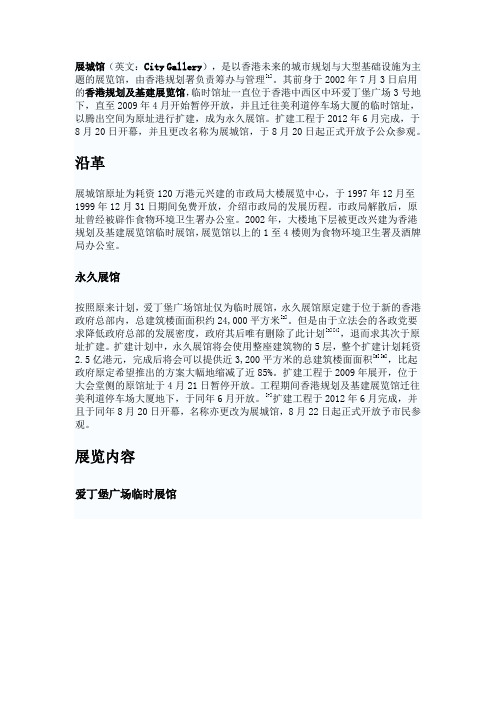
展城馆(英文:City Gallery),是以香港未来的城市规划与大型基础设施为主题的展览馆,由香港规划署负责筹办与管理[1]。
其前身于2002年7月3日启用的香港规划及基建展览馆,临时馆址一直位于香港中西区中环爱丁堡广场3号地下,直至2009年4月开始暂停开放,并且迁往美利道停车场大厦的临时馆址,以腾出空间为原址进行扩建,成为永久展馆。
扩建工程于2012年6月完成,于8月20日开幕,并且更改名称为展城馆,于8月20日起正式开放予公众参观。
沿革展城馆原址为耗资120万港元兴建的市政局大楼展览中心,于1997年12月至1999年12月31日期间免费开放,介绍市政局的发展历程。
市政局解散后,原址曾经被辟作食物环境卫生署办公室。
2002年,大楼地下层被更改兴建为香港规划及基建展览馆临时展馆,展览馆以上的1至4楼则为食物环境卫生署及酒牌局办公室。
永久展馆按照原来计划,爱丁堡广场馆址仅为临时展馆,永久展馆原定建于位于新的香港政府总部内,总建筑楼面面积约24,000平方米[2]。
但是由于立法会的各政党要求降低政府总部的发展密度,政府其后唯有删除了此计划[3][4],退而求其次于原址扩建。
扩建计划中,永久展馆将会使用整座建筑物的5层,整个扩建计划耗资2.5亿港元,完成后将会可以提供近3,200平方米的总建筑楼面面积[5][6],比起政府原定希望推出的方案大幅地缩减了近85%。
扩建工程于2009年展开,位于大会堂侧的原馆址于4月21日暂停开放。
工程期间香港规划及基建展览馆迁往美利道停车场大厦地下,于同年6月开放。
[7]扩建工程于2012年6月完成,并且于同年8月20日开幕,名称亦更改为展城馆,8月22日起正式开放予市民参观。
展览内容爱丁堡广场临时展馆位于大会堂侧的旧馆址(于2009年4月关闭)展馆位于中环爱丁堡广场3号地下,位于香港大会堂低座旁边,占地约460平方米,由The Oval Partnership设计,于2002年7月3日至2009年4月20日期间运作。
香港便览 - 历史档案馆

香港便览历史档案馆政府档案处的历史档案馆是香港特别行政区(香港特区)政府集中贮存具永久价值的档案的地方。
所有档案现存放于九龙观塘翠屏道13号的香港历史档案大楼内。
这座大楼于1997年6月启用,大楼无论在设计、建筑和设备方面,都力求符合各项有关历史档案保护的国际标准。
主要职能:历史档案馆的主要职能:档案鉴定与整理,以及公共推广服务。
档案鉴定与整理:鉴定档案价值和选取历史档案是该馆管理历史档案的第一步工作。
鉴定档案价值的工作十分重要。
在进行这项工作时,该馆会作出仔细的研究和分析,然后根据分析结果,决定哪些档案富历史价值和长远来说亦具研究价值,最后把档案移交历史档案馆作永久保留。
当档案移交至历史档案馆后,该馆会加以整理及着录,并编订各种分类目录和索引,方便公众人士查阅。
经过多年,历史档案馆已制定和实行一套持续的档案鉴定、移交、整理和着录程序。
按目前政府档案的管理程序,部门在销毁任何档案前,必须谘询政府档案处的意见,任何与销毁档案有关的决定,均须妥为记录。
公共推广服务:为了让公众进一步了解历史档案馆的藏品和所提供的服务,该馆不时举办展览、研讨会、工作坊、探访和其他形式的教育活动。
为了推广使用历史档案作研习用途,历史档案馆建立了好些研习历史和通识等科目的教育资源。
公众人士可透过登入政府档案处的网页(.hk),查阅教学资源页的参考资料。
藏品:历史档案馆现存的档案,大都是1945年英国恢复管治香港后产生的档案。
虽然在日军占领香港期间,大量政府档案散佚,但仍有几类重要的战前档案得以保存下来,存放于历史档案馆内。
田土及法庭档案:最具研究价值的要算是几类与土地有关的档案,其中包括1858年至1983年的差饷征收册、1843年至1960年的官地地税册、1856年至1960年的村地地税册、1846年至1975年的官地地契登记册及自一八四零年代中期以来归还业权的契约。
历史档案馆亦存有1866年至1940年布政司署有关土地事宜的来往公文,以及1841年至1928年各类人士履行合约、义务所涉及的契约文件。
香港 - 城市规划条例 (英文)

Chapter: 131 TOWN PLANNING ORDINANCE Gazette Number Version DateLong title 30/06/1997 To promote the health, safety, convenience and general welfare of the community by making provision for the systematic preparation and approval of plans for the lay-out of areas of Hong Kong as well as for the types ofbuilding suitable for erection therein and for the preparation and approval of plans for areas within whichpermission is required for development.(Amended 4 of 1991 s. 2)[23 June 1939](Originally 20 of 1939 (Cap 131 1950))Section: 1 Short title 30/06/1997 This Ordinance may be cited as the Town Planning Ordinance.Section: 1A Interpretation L.N. 50 of 2005 10/06/2005 In this Ordinance, unless the context otherwise requires-"Appeal Board" (上訴委員會) means an Appeal Board constituted under section 17A; (Added 101 of 1991 s. 2) "Authority" (監督) means the Director of Planning;"building" (建築物) includes a structure or part of a structure;"container" (貨櫃) includes a container converted for use as an accommodation or as storage or for any other use;(Added 22 of 1994 s. 2)"development" (發展) means carrying out building, engineering, mining or other operations in, on, over or under land, or making a material change in the use of land or buildings;"development permission area" (發展審批地區) means an area so designated in a plan prepared under sections 3(1)(b) and 20 but does not include land included in a plan of an interim development permission area;"existing use" (現有用途) in relation to a development permission area means a use of a building or land that was in existence immediately before the publication in the Gazette of notice of the draft plan of the developmentpermission area;"interim development permission area" (中期發展審批地區) means an area so designated in a plan prepared under section 26;"land owner" (土地擁有人) has the same meaning as "owner" in section 2(1) of the Buildings Ordinance (Cap 123);"material change in the use of land or buildings" (土地或建築物用途的實質改變) includes depositing matter on land, notwithstanding that all or part of the land is already used for depositing matter, if the area, height oramount of the deposit is increased;"occupier" (佔用人) includes a tenant of a land owner whether or not he pays rent, a person who resides in a building and a person who carries on a full-time occupation in a building;"prescribed fee" (訂明費用), in relation to any matter, means the fee prescribed in relation to that matter by a regulation made under section 14(2); (Added 25 of 2004 s. 2)"property" (財產) includes anything contained in a vehicle or a container, but does not include immovable property;(Added 22 of 1994 s. 2)"unauthorized development" (違例發展) means-(a) in relation to land included in a plan of a development permission area or described in section 20(7),development in contravention of this Ordinance; and(b) in sections 22 and 23, in relation to land referred to in section 23(4), development other thandevelopment permitted under a plan of an interim development permission area, undertaken on or afterthe date on which notice of that plan is gazetted.(Added 4 of 1991 s. 3) Section: 2 Appointment of Town Planning Board L.N. 50 of 2005 10/06/2005(1) The Chief Executive may appoint a Town Planning Board consisting of such official and unofficial members as he may nominate, and may appoint any member of the Board, either ex officio or personally, as chairman or vice-chairman and any public officer as secretary thereof. (Amended 62 of 2000 s. 3)(2) 5 members of the Board, one of whom must be the chairman or vice-chairman, shall form a quorum at any meeting of the Board.(3) For the better discharge of the functions of the Board under this Ordinance the Chief Executive may, by notice in the Gazette, from among the members of the Board, appoint committees of the Board and a chairman and vice-chairman of each committee. (Added 4 of 1991 s. 4. Amended 62 of 2000 s. 3)(4) 5 members of a committee appointed under subsection (3), one of whom must be the chairman or a vice-chairman and 3 of whom must be persons who are not official members, shall form a quorum at any meeting of the committee. (Added 4 of 1991 s. 4)(5) The Board may delegate any of its powers and functions-(a) under sections 3, 4(1), 4A, 5, 7(1) to (3), 8, 12A, 16, 16A and 20(1) to a committee appointed undersubsection (3);(b) to a public officer or class of public officer in respect of- (Amended 25 of 2004 s. 3)(i) an application made under section 16A(2); and (Replaced 25 of 2004 s. 3)(ii) an application for permission for development within a development permission area on condition that the development is discontinued and the land reinstated, as directed by the publicofficer, within 6 months after the permission is granted; and(c) under sections 12A(13) and (15), 16(2J) and (2L) and 17(2H) and (2J) to the secretary of the Board,(Added 25 of 2004 s. 3)and, for the avoidance of doubt, the provisions of this Ordinance shall, with necessary modifications, be construed and have application accordingly. (Added 4 of 1991 s. 4. Amended 25 of 2004 s. 3)Section: 2A Appointment of committees by the Board L.N. 50 of 2005 10/06/2005(1) Notwithstanding section 2(3), the Board may appoint committees from among its members to exercise any of the Board's powers and functions under sections 6B, 6C, 6D, 6E, 6F, 6G and 6H, and, for the avoidance of doubt, the provisions of this Ordinance shall, with necessary modifications, be construed and have application accordingly. (Amended 25 of 2004 s. 4)(2) A committee appointed under this section shall consist of not less than 5 members at least 3 of whom are not public officers.(3) The Board shall, from the members of a committee appointed under this section, appoint one member to be Chairman of the committee and one member to be Deputy Chairman of the committee.(4) The quorum for a committee is the Chairman or Deputy Chairman and 2 members.(5) Notwithstanding subsection (4), a committee shall not meet or continue to meet unless a majority of those present are not public officers.(Added 16 of 1998 s. 2) Section: 2B Transaction of business by circulation of papers L.N. 50 of 2005 10/06/2005(1) The Board or any committee appointed under section 2(3) or 2A may transact any of its business by the circulation of papers among its members, whether any such member is in or outside Hong Kong, unless the holding of a meeting for the purpose is required either by any express provision of this Ordinance or by necessary implication from any provision of this Ordinance.(2) Subject to subsections (3) and (4), upon the circulation of papers under subsection (1), a resolution in writing which is approved in writing by a majority of the members of the Board or of a committee appointed under section 2(3) or 2A shall be as valid and effectual as if it had been a resolution passed at a meeting of the Board or the committee, as the case may be, by the votes of the members by whom the resolution is so approved.(3) Any member of the Board or of a committee appointed under section 2(3) or 2A may require any business which is being transacted by the circulation of papers under subsection (1) to be transacted at a meeting of the Boardor of the committee, as the case may be, by giving a notice in writing to the chairman of the Board or of the committee, as the case may be, within the period specified in the papers.(4) Where, in respect of any business being transacted by the circulation of papers, a notice is given under subsection (3) to the chairman of the Board or of a committee appointed under section 2(3) or 2A, any resolution approved in writing under subsection (2) in respect of the business shall be void.(5) For the avoidance of doubt, a reference to circulation of papers in this section includes circulation of information by electronic means, and the reference to the papers in this section shall be construed accordingly.(Added 25 of 2004 s. 5) Section: 2C Meetings of Board and of committees L.N. 50 of 2005 10/06/2005(1) Subject to subsection (2), all meetings of the Board or of any committee appointed under section 2(3) or 2A shall be open to the public.(2) Subsection (1) does not apply to—(a) in the case of any meeting held under or for the purposes of section 6B, 6F, 12A, 16, 16A or 17, suchpart or parts of the meeting that are held for deliberation by the Board or the committee, as the casemay be, for making any decision under section 6B(8), 6F(8) (whether with or without application ofsection 6F(9)), 12A(23), 16(3), 16A(5) or 17(6), after hearing any person who, not being a member ofthe Board or the committee, as the case may be, is entitled or allowed to be heard or otherwise has anopportunity of making representations or providing information at the meeting; and(b) in the case of any other meeting, the meeting or any part or parts of the meeting if in the opinion of theBoard or the committee, as the case may be, it is likely that—(i) the application of subsection (1) to such meeting or such part or parts of the meeting, as the casemay be, would not be in the public interest;(ii) the application of subsection (1) to such meeting or such part or parts of the meeting, as the case may be, would result in premature release of information that would prejudice the position of theBoard, the Government, the Chief Executive or the Chief Executive in Council or, in the case ofa meeting of the committee, the committee in carrying out its or his functions under thisOrdinance;(iii) the application of subsection (1) to such meeting or such part or parts of the meeting, as the case may be, would result in a disclosure of information in breach of any duty of confidentiality owedto any person by the Board or the Government or, in the case of a meeting of the committee, thecommittee, or owed to the Government by the Board or, in the case of a meeting of thecommittee, the committee, by virtue of any law or any requirement under any law, or incontravention of any prohibition by any order of a magistrate or a court or by any law or anyrequirement under any law;(iv) the application of subsection (1) to such meeting or such part or parts of the meeting, as the case may be, would result in a disclosure of information in respect of which a claim to legalprofessional privilege could be maintained in law; or(v) any matter transacted at such meeting or such part or parts of the meeting, as the case may be, would be relevant to the institution or conduct of any legal proceedings.(3) Subject to the provisions of this Ordinance, the Board or any committee appointed under section 2(3) or 2A may determine its practice and procedure at its meeting.(Added 25 of 2004 s. 5) Section: 3 Functions of the Board 62 of 2000 01/07/1997 Remarks:Adaptation amendments retroactively made - see 62 of 2000 s. 3(1) With a view to the promotion of the health, safety, convenience and general welfare of the community, the Board shall undertake the systematic preparation of-(a) draft plans for the lay-out of such areas of Hong Kong as the Chief Executive may direct, as well as forthe types of building suitable for erection therein; and(b) draft development permission area plans of such areas of Hong Kong as the Chief Executive maydirect. (Amended 62 of 2000 s. 3)(2) In the course of preparation of the plans referred to in subsection (1), the Board shall make such inquiriesand arrangements (including, if it thinks fit, the taking of any census of the occupants of any buildings or of the usersof any thoroughfares or spaces) as it may consider necessary for the preparation of such drafts.(Replaced 4 of 1991 s. 5)01/07/1997Section: 4 Contents of lay-out plans and powers of the Board 29 of 1998; 62 of2000Remarks:Adaptation amendments retroactively made - see 29 of 1998 s. 44; 62 of 2000 s. 3(1) The Board's draft plans prepared under section 3(1)(a) for the lay-out of any such area may show or makeprovision for- (Amended 4 of 1991 s. 6)(a) streets, railways and other main communications;(b) zones or districts set apart for use for residential, commercial, industrial or other specified uses;(c) reserves for Government, institution or community purposes;(d) parks, recreation grounds and similar open spaces;(e) zones or districts set apart for undetermined uses;(f) comprehensive development areas; (Added 2 of 1988 s. 2)*(g) country parks, coastal protection areas, sites of special scientific interest, green belts or other specified uses that promote conservation or protection of the environment; (Added 4 of 1991 s. 6)*(h) zones or districts set apart for use for village type development, agriculture or other specified rural uses; (Added 4 of 1991 s. 6)*(i) zones or districts set apart for use for open storage, (Added 4 of 1991 s. 6)and any matter whatsoever may be shown or provided for or specified in or in respect of the plans by means of suchdiagrams, illustrations, notes or descriptive matter as the Board thinks appropriate; and any such diagrams, illustrations, notes and descriptive matter shall be part of the plans. (Replaced 59 of 1974 s. 2)(2) The Board may recommend to the Chief Executive in Council the resumption of any land that interfereswith the lay-out of an area shown on a draft or approved plan or on a master lay-out plan approved under section 4A;and resumption to avoid such interference shall be deemed to be resumption for a public purpose within the meaningof the Lands Resumption Ordinance (Cap 124). (Amended 2 of 1988 s. 2; 29 of 1998 s. 44; 62 of 2000 s. 3)(3) Except in the case of resumption under the said Ordinance no compensation shall be paid to the proprietoror any person interested in any holding by reason of the fact that it lies within or is affected by any zone or district setapart under subsection (1)(b)._____________________________________________________________________________Note:* See 4 of 1991 s. 1(2) as to date of operation.Section: 4A Comprehensive development areas 30/06/1997(1) Without restricting what the Board may, under sections 3 and 4, show or make provision for in a plan, theBoard may, by a note on the plan, in respect of a comprehensive development area, prohibit the undertaking of anybuilding works, as defined in the Buildings Ordinance (Cap 123), except-(a) as specified in the note; or(b) with the permission of the Board, which permission may be granted by reference to a plan approved bythe Board under subsection (2).(2) An applicant for the Board's permission under subsection (1)(b) may be required by the Board-(a) to prepare a master lay-out plan and submit it to the Board for approval; and(b) to include information in the master lay-out plan respecting building dimensions, floor area for eachuse, building development programmes and any other matter the Board considers appropriate.(3) A copy of the approved master lay-out plan, certified by the Chairman of the Board, shall be deposited inthe Land Registry and shall be available for inspection without payment of a fee. (Amended 8 of 1993 s. 2)(Added 2 of 1988 s. 3)Section: 5 Exhibition of draft plans L.N. 50 of 2005 10/06/2005 Any draft plan, prepared under sections 3 and 4 under the direction of the Board, which the Board deems suitable for publication, shall be exhibited by the Board for public inspection at reasonable hours for a period of 2 months. During such period the Board shall advertise once a week in 2 daily Chinese language local newspapers and 1 daily English language local newspaper and shall notify in each issue of the Gazette the place and hours at which such plan may be inspected. The Board shall supply a copy of such plan to any person on payment of such fee as the Board may determine.(Amended 26 of 1956 s. 2; 59 of 1969 s. 3; 2 of 1988 s. 4; 25 of 2004 s. 6) Section: 6 Representations relating to draft plans L.N. 50 of 2005 10/06/2005(1) Within the period of 2 months during which a draft plan is exhibited under section 5, any person may make representation to the Board in respect of the draft plan.(2) A representation referred to in subsection (1) shall—(a) indicate—(i) the particular matter in the draft plan to which the representation relates;(ii) the nature of and reasons for the representation; and(iii) the amendments (if any) proposed by the person to the draft plan; and(b) be made in such manner as the Board requires.(3) Where a representation referred to in subsection (1)—(a) is made to the Board after the expiration of the period of 2 months referred to in subsection (1), it shallbe treated as not having been made; or(b) does not comply with any of the requirements specified in or made under subsection (2), it may betreated as not having been made.(4) The Board shall, as soon as reasonably practicable after the expiration of the period of 2 months referred to in subsection (1), make all representations made to it under that subsection available for public inspection at reasonable hours, and shall continue to do so until the Chief Executive in Council has made a decision in respect of the draft plan in question under section 9.(5) In respect of any representations which are available for public inspection under subsection (4), the Board shall cause a notice that complies with subsection (6) to be published in 2 daily Chinese language local newspapers and 1 daily English language local newspaper once a week during the first 3 weeks of the period during which the representations are so available for public inspection.(6) A notice referred to in subsection (5) shall—(a) specify the place and hours at which the representations to which the notice relates are available forpublic inspection under subsection (4); and(b) indicate that comments may be made to the Board in respect of the representations under section 6A(1)and specify the place and hours at which any comments so made will be available for public inspectionunder section 6A(4).(Replaced 25 of 2004 s. 7) Section: 6A Comments on representations L.N. 50 of 2005 10/06/2005(1) Within the first 3 weeks of the period during which any representation is available for public inspection under section 6(4), any person may make comment to the Board in respect of the representation.(2) Any comment referred to in subsection (1) shall be made in such manner as the Board requires.(3) Where any comment referred to in subsection (1)—(a) is made to the Board after the expiration of the period of 3 weeks referred to in subsection (1), it shallbe treated as not having been made; or(b) does not comply with any of the requirements made under subsection (2), it may be treated as nothaving been made.(4) The Board shall, as soon as reasonably practicable after the expiration of the period of 3 weeks referred to in subsection (1), make all comments made to it under that subsection available for public inspection at reasonable hours, and shall continue to do so until the Chief Executive in Council has made a decision in respect of the draft planin question under section 9.(Added 25 of 2004 s. 8) Section: 6B Consideration of representations, etc. L.N. 50 of 2005 10/06/2005(1) Where any representation is made under section 6(1), the Board shall hold a meeting to consider the representation, as well as any comment made in respect of the representation under section 6A(1), as soon as reasonably practicable after the expiration of the period of 3 weeks referred to in section 6A(1).(2) The Board shall, in respect of any meeting to be held under subsection (1), give reasonable notice of particulars of the meeting (including the date, time and place of the meeting) to—(a) the person who made the representation to which the meeting relates under section 6(1); and(b) the persons (if any) who made any comment in respect of the representation under section 6A(1).(3) At a meeting held under subsection (1)—(a) the person who made the representation to which the meeting relates under section 6(1); and(b) the persons (if any) who made any comment in respect of the representation under section 6A(1),are entitled to attend and to be heard, either in person or by an authorized representative.(4) If, at a meeting held under subsection (1), any of the persons entitled to attend and to be heard at the meeting under subsection (3) fails to attend, either in person or by an authorized representative, the Board may—(a) proceed with the meeting in his absence; or(b) adjourn the meeting to such date as it considers appropriate.(5) Without prejudice to subsection (4), where the Board is satisfied that there are reasonable grounds to do so, it may adjourn any meeting held or to be held under subsection (1) to such date as it considers appropriate.(6) The Board may direct that all or some of the representations made in respect of the draft plan in question under section 6(1) shall be considered at the same meeting, whereupon such representations, as well as any comment made in respect of any of such representations—(a) shall be considered at the same meeting; and(b) may be considered by the Board either individually or collectively as it may determine.(7) Where—(a) any meeting is adjourned under subsection (4) or (5); or(b) the Board makes a direction under subsection (6),the provisions of this section also apply, with necessary modifications, to the meeting so adjourned or the meeting held in accordance with the direction, as the case may be, save to the extent that the Board otherwise directs.(8) Upon consideration of any representation, as well as any comment, at a meeting under subsection (1), the Board shall decide whether or not to propose amendments to the draft plan in question in the manner proposed in the representation or otherwise in the manner that, in the opinion of the Board, will meet the representation.(Added 25 of 2004 s. 8)L.N. 50 of 2005 10/06/2005 Section: 6C Proposed amendments under section 6B(8) to be madeavailable for public inspection(1) Where the Board proposes any amendments under section 6B(8), the Board shall, as soon as reasonably practicable after the amendments are proposed, make the proposed amendments available for public inspection at reasonable hours, and shall continue to do so until the Chief Executive in Council has made a decision in respect of the draft plan in question under section 9.(2) In respect of any proposed amendments which are available for public inspection under subsection (1), the Board shall cause a notice that complies with subsection (3) to be published in 2 daily Chinese language local newspapers and 1 daily English language local newspaper once a week during the first 3 weeks of the period during which the proposed amendments are so available for public inspection.(3) A notice referred to in subsection (2) shall—(a) specify the place and hours at which the proposed amendments to which the notice relates are availablefor public inspection under subsection (1); and(b) indicate that further representations may be made to the Board in respect of the proposed amendmentsunder section 6D(1) and specify the place and hours at which any further representations so made willbe available for public inspection under section 6D(4).(Added 25 of 2004 s. 8)Section: 6D Further representations in respect of proposedL.N. 50 of 2005 10/06/2005 amendments(1) Where the Board proposes any amendments under section 6B(8), within the first 3 weeks of the period during which the proposed amendments are available for public inspection under section 6C(1), any person, other than that who has made any representation or comment after consideration of which the proposed amendments are proposed under section 6B(8), may make further representation to the Board in respect of the proposed amendments.(2) A further representation referred to in subsection (1) shall—(a) indicate—(i) the proposed amendments to which the further representation relates;(ii) whether the further representation is made in support of, or in opposition to, the proposed amendments; and(iii) the reasons for the further representation; and(b) be made in such manner as the Board requires.(3) Where a further representation referred to in subsection (1)—(a) is made to the Board after the expiration of the period of 3 weeks referred to in subsection (1), it shallbe treated as not having been made; or(b) does not comply with any of the requirements specified in or made under subsection (2), it may betreated as not having been made.(4) The Board shall, as soon as reasonably practicable after the expiration of the period of 3 weeks referred to in subsection (1), make all further representations made to it under that subsection available for public inspection at reasonable hours, and shall continue to do so until the Chief Executive in Council has made a decision in respect of the draft plan in question under section 9.(Added 25 of 2004 s. 8)Section: 6E Withdrawal of representations, etc. L.N. 50 of 2005 10/06/2005(1) Any person who makes any representation under section 6(1), or makes any comment in respect of any such representation under section 6A(1), may by notice in writing to the Board withdraw the representation or comment, as the case may be, at any time before the representation or comment, as the case may be, has been considered at a meeting under section 6B(1).(2) Any person who makes any further representation under section 6D(1) may by notice in writing to the Board withdraw the further representation at any time before the further representation has been considered at a meeting under section 6F(1).(3) Where any representation, comment or further representation is withdrawn under subsection (1) or (2)—(a) the representation, comment or further representation, as the case may be, shall thereafter be treated asnot having been made; and(b) in the case of the withdrawal of any representation, any comment made under section 6A(1) in respectof the representation shall thereafter be treated as not having been made.(Added 25 of 2004 s. 8)Section: 6F Consideration of further representations in respect ofL.N. 50 of 2005 10/06/2005 proposed amendments(1) Where any further representation is made under section 6D(1), the Board shall hold a meeting to consider the further representation as soon as reasonably practicable after the expiration of the period of 3 weeks referred to in that section.(2) The Board shall, in respect of any meeting to be held under subsection (1), give reasonable notice of particulars of the meeting (including the date, time and place of the meeting) to—(a) the person who made the further representation to which the meeting relates under section 6D(1); and(b) the person who made any representation or comment after consideration of which the proposedamendments in question are proposed under section 6B(8).(3) At a meeting held under subsection (1)—(a) the person who made the further representation to which the meeting relates under section 6D(1); and(b) the person who made any representation or comment after consideration of which the proposedamendments in question are proposed under section 6B(8),are entitled to attend and to be heard, either in person or by an authorized representative.(4) If, at a meeting held under subsection (1), any of the persons entitled to attend and to be heard at the meeting under subsection (3) fails to attend, either in person or by an authorized representative, the Board may—(a) proceed with the meeting in his absence; or(b) adjourn the meeting to such date as it considers appropriate.(5) Without prejudice to subsection (4), where the Board is satisfied that there are reasonable grounds to do so, it may adjourn any meeting held or to be held under subsection (1) to such date as it considers appropriate.(6) The Board may direct that all further representations made in respect of the proposed amendments in question under section 6D(1) shall be considered at the same meeting, whereupon such further representations—(a) shall be considered at the same meeting; and(b) may be considered by the Board either individually or collectively as it may determine.(7) Where—(a) any meeting is adjourned under subsection (4) or (5); or(b) the Board makes a direction under subsection (6),the provisions of this section also apply, with necessary modifications, to the meeting so adjourned or the meeting held in accordance with the direction, as the case may be, save to the extent that the Board otherwise directs.(8) Upon consideration of any further representation at a meeting under subsection (1), the Board shall decide whether or not to amend the draft plan in question, either by the proposed amendments in question, or by the proposed amendments as further varied in such manner as it considers appropriate.(9) Where, in respect of any proposed amendments proposed under section 6B(8), any further representation is made under section 6D(1) but no such further representation indicates under section 6D(2)(a)(ii) that it is made in opposition to the proposed amendments—(a) subsections (3) and (4) shall not have application to any meeting to be held under subsection (1) inrespect of any such further representation, and the other provisions of this section shall, with necessarymodifications, be construed and have application accordingly; and(b) subsection (8) shall be construed as requiring the Board, upon consideration of any such furtherrepresentation, to amend the draft plan in question by the proposed amendments.(Added 25 of 2004 s. 8)L.N. 50 of 2005 10/06/2005 Section: 6G Cases where there are no further representations inrespect of proposed amendmentsWhere, in respect of any proposed amendments proposed under section 6B(8), no further representation is made under section 6D(1) within the period of 3 weeks referred to in that section, the Board shall, as soon as reasonably practicable after the expiration of the period, amend the draft plan in question by the proposed amendments.(Added 25 of 2004 s. 8) Section: 6H Effect of amendments under section 6F or 6G L.N. 50 of 2005 10/06/2005(1) Where the Board amends a draft plan under section 6F(8) (whether with or without application of section 6F(9)) or 6G, the draft plan shall thereafter be read as including the amendments, and, for the avoidance of doubt, any reference to the draft plan (however described) in this or any other Ordinance shall, unless the context otherwise requires, be construed accordingly.(2) Where any draft plan is read as including any amendments under subsection (1), the Board shall, as soon as reasonably practicable thereafter, make the amendments available for public inspection at reasonable hours, and shall continue to do so until the Chief Executive in Council has made a decision in respect of the draft plan under section 9.(Added 25 of 2004 s. 8)。
香港城市规划体系
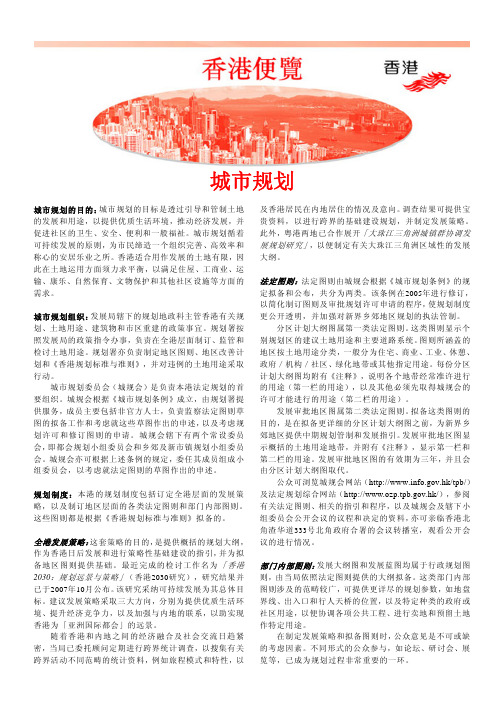
城市规划城市规划的目的:城市规划的目标是透过引导和管制土地的发展和用途,以提供优质生活环境,推动经济发展,并促进社区的卫生、安全、便利和一般福祉。
城市规划循着可持续发展的原则,为市民缔造一个组织完善、高效率和称心的安居乐业之所。
香港适合用作发展的土地有限,因此在土地运用方面须力求平衡,以满足住屋、工商业、运输、康乐、自然保育、文物保护和其他社区设施等方面的需求。
城市规划组织:发展局辖下的规划地政科主管香港有关规划、土地用途、建筑物和市区重建的政策事宜。
规划署按照发展局的政策指令办事,负责在全港层面制订、监管和检讨土地用途。
规划署亦负责制定地区图则、地区改善计划和《香港规划标准与准则》,并对违例的土地用途采取行动。
城市规划委员会(城规会)是负责本港法定规划的首要组织。
城规会根据《城市规划条例》成立,由规划署提供服务,成员主要包括非官方人士,负责监察法定图则草图的拟备工作和考虑就这些草图作出的申述,以及考虑规划许可和修订图则的申请。
城规会辖下有两个常设委员会,即都会规划小组委员会和乡郊及新市镇规划小组委员会。
城规会亦可根据上述条例的规定,委任其成员组成小组委员会,以考虑就法定图则的草图作出的申述。
规划制度:本港的规划制度包括订定全港层面的发展策略,以及制订地区层面的各类法定图则和部门内部图则。
这些图则都是根据《香港规划标准与准则》拟备的。
全港发展策略:这套策略的目的,是提供概括的规划大纲,作为香港日后发展和进行策略性基础建设的指引,并为拟备地区图则提供基础。
最近完成的检讨工作名为「香港2030:规划远景与策略」(香港2030研究),研究结果并已于2007年10月公布。
该研究采纳可持续发展为其总体目标。
建议发展策略采取三大方向,分别为提供优质生活环境、提升经济竞争力,以及加强与内地的联系,以助实现香港为「亚洲国际都会」的远景。
随着香港和内地之间的经济融合及社会交流日趋紧密,当局已委托顾问定期进行跨界统计调查,以搜集有关跨界活动不同范畴的统计资料,例如旅程模式和特性,以及香港居民在内地居住的情况及意向。
香港便览-香港邮政-GovHKResidents

香港便覽香港邮政香港能够发展成为一个领先的金融和工商业中心,主要原因之一,是邮政服务质素甚高。
香港邮政的目标,是以合理的收费,提供可靠、高效率和贯通全球的邮政服务,以切合市民的需要,并履行香港所肩负的国际邮政义务。
邮政服务:香港法例授权香港邮政处理本地和海外邮件,以及转寄往其他地方的邮件。
香港邮政由香港邮政署长掌管。
香港邮政与世界各地的邮件往来早在1841年开始。
随 本港人口增长,商业迅速发展,香港邮政所提供的服务范围日渐扩大,水准亦日见提高。
截至2014年10月,邮政局的数目有127间,其中32间位于港岛,36间位于九龙,57间则位于新界和离岛,另有两间流动邮政局。
在2013-14年度,平均每日处理的邮件量达338万件,所处理的邮件中,逾90%来自工商界,足以证明香港邮政在促进香港工商业发展方面,扮演着重要的角色。
香港邮政于1995年8月1日起转以营运基金方式运作。
这个新的身分,让香港邮政在财政方面享有高度自主,以便更有效地回应不断改变的市场和顾客需求,并推出新措施和作出改善。
虽然香港邮政在财政和会计架构方面有所改变,但仍属政府部门。
信件邮寄服务:在2013-14年度,香港邮政处理的本地信件达10.36亿封。
本地投寄的信件当中,99%在投寄后的下一个工作日派达,而以优惠邮费投寄的大量优惠级邮件则可于三个工作日内派达。
海外信件邮寄服务包括空邮、大量投寄空邮、平邮、大量投寄邮袋和代寄商邮袋。
在2013-14年度,寄往海外目的地的空邮和平邮信件共达1.65亿封。
包裹服务:香港邮政亦提供本地和海外包裹服务。
顾客可以空邮或平邮方式邮寄包裹往约230个海外目的地。
在2013-14年度,香港邮政处理的国际及本地包裹约132万件。
服务标准是在两个工作日内把本地和入口包裹派达香港、九龙和新界各主要工商业区的收件人。
特快专递服务:特快专递是香港邮政提供的国际速递服务,亦是万国邮政联盟(万国邮联)环球特快专递服务在香港的品牌名称。
香港新城区旧城区规划方案
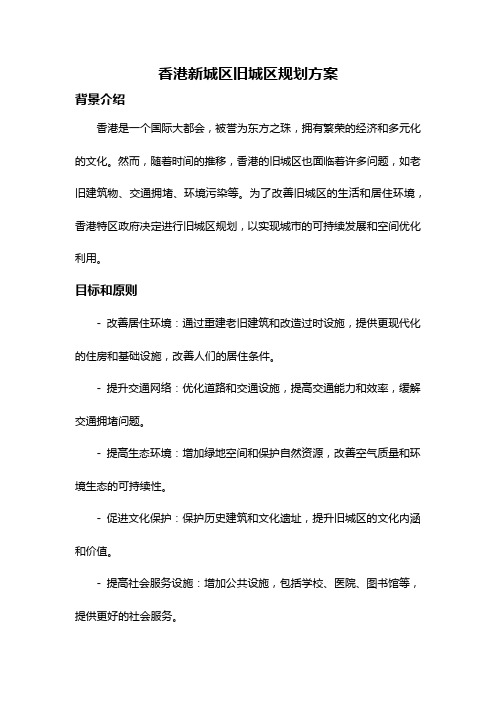
香港新城区旧城区规划方案背景介绍香港是一个国际大都会,被誉为东方之珠,拥有繁荣的经济和多元化的文化。
然而,随着时间的推移,香港的旧城区也面临着许多问题,如老旧建筑物、交通拥堵、环境污染等。
为了改善旧城区的生活和居住环境,香港特区政府决定进行旧城区规划,以实现城市的可持续发展和空间优化利用。
目标和原则- 改善居住环境:通过重建老旧建筑和改造过时设施,提供更现代化的住房和基础设施,改善人们的居住条件。
- 提升交通网络:优化道路和交通设施,提高交通能力和效率,缓解交通拥堵问题。
- 提高生态环境:增加绿地空间和保护自然资源,改善空气质量和环境生态的可持续性。
- 促进文化保护:保护历史建筑和文化遗址,提升旧城区的文化内涵和价值。
- 提高社会服务设施:增加公共设施,包括学校、医院、图书馆等,提供更好的社会服务。
规划内容1. 住房改善- 对老旧建筑进行重建,提供现代化住房,满足居民对品质生活的需求。
- 加强住房供应,增加价格合理的经济适用住房,满足低收入家庭的需求。
- 改善公共住房,提高管理质量和居住环境,使其具有更好的生活品质。
2. 交通优化- 修建新的道路和交通枢纽,提高交通容量和效率。
- 发展捷运系统,建设地铁和轻轨交通网络,方便市民的出行。
- 鼓励人们使用公共交通工具,并推广绿色出行方式,减少汽车使用量。
3. 环境保护- 增加绿地空间和城市公园,提供更多休闲活动场所,改善居民的生活质量。
- 提升环境保护意识,加强废物处理和垃圾分类,促进可持续的资源利用和循环经济。
- 推广绿色建筑和节能环保技术,减少碳排放和能源消耗。
4. 文化与历史保护- 保护历史建筑和文化遗迹,修复和恢复有价值的历史建筑物。
- 建设文化街区和艺术中心,提供展览和表演场所,促进艺术和文化交流。
- 建立文化遗产保护基金,为文化保护项目提供资金支持和保障。
5. 社会服务设施- 建设更多的学校、医院、图书馆等社会服务设施,提供全方位的社区服务。
[2017年整理]香港的城市规划体系
![[2017年整理]香港的城市规划体系](https://img.taocdn.com/s3/m/bd43f647f11dc281e53a580216fc700abb6852e1.png)
香港的城市规划体系——规划运作体系一、发展规划香港的发展规划分为全港、次区域和地区三个层面,因而形成港发展策略、次区域发展策略及地区图则三层架构的发展规划系统。
《香港规划标准与准则》是技术政策文件,列明各类土地用途在设施配置方面的标准,同时也为公私发展计划的规划大纲提供指导。
1、全港和次区域发展策略全港发展策略制订长远规划大纲,贯彻政府的土地用途、交通基础设施及环境方面的政策,作为次区域及地区规划的依据。
次区域发展策略将全港发展目标在五个次区域(即都会区、新界东北、新界西北、新界东南及新界西南)演绎为更具体的规划目标。
2、地区图则地区图则是详细的土地用途图则,将全港及次区域层面的概要规划原则在地区层面加以落实。
地区图则分为法定图则及政府内部图则两类。
法定图则根据《城市规划条例》而制订,包括分区计划大纲图和发展审批地区图。
分区计划大纲图明确规划分区内的拟议土地用途(包括住宅、商业、工业、游憩用地、政府/团体/社区用途、绿化地带、保护区、综合发展区、乡村式发展、露天存货或其它指定用途)和主要道路系统。
分区计划大纲图附有注释,列出分区内通常准许的用途(第1栏用途),以及其它须取得规划委员会许可的用途(第2栏用途)。
发展审批地区图主要为非城市地区而制订的过渡性图则,有效期为3年,期间可由分区计划大纲图取代。
3、规划图则的编制依照《城市规划条例》的法定程序,法定图则由规划委员会遵照特区行政长官会同行政局的指令制订。
在制订新的分区计划大纲图或对现有图则进行重要修订前,须先公布规划研究报告,供公众查阅和发表意见。
规划委员会在制订或修订图则时,将会考虑规划研究报告和公众意见。
图则草案送交各有关部门传阅以征询意见,然后提交有关的规划小组委员会审议。
如规划小组委员会认为适当的话,该图便会提交有关的区议会征询意见,然后再由规划委员会考虑区议会的意见。
图则草案公开展示2个月,供市民发表意见,受图则影响的人士可在些期间提出反对。
香港便览 - 郊野公园及自然护理
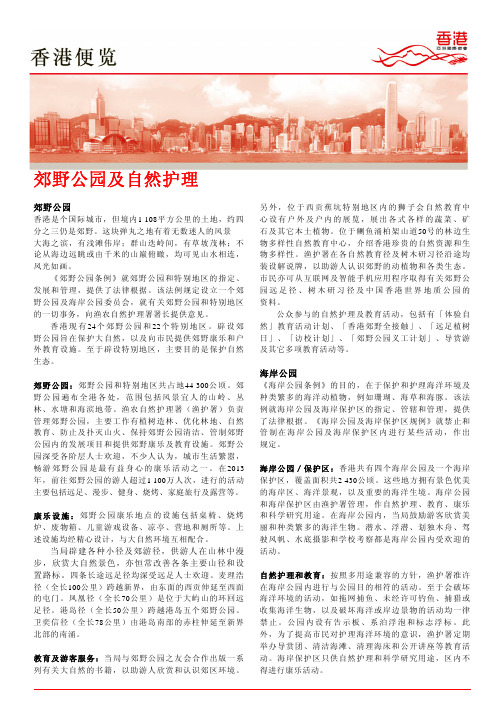
香港便覽郊野公园及自然护理郊野公园香港是个国际城市,但境内1 108平方公里的土地,约四分之三仍是郊野。
这块弹丸之地有着无数迷人的风景 — 大海之滨,有浅滩伟岸;群山迭岭间,有草坡茂林;不论从海边远眺或由千米的山巅俯瞰,均可见山水相连,风光如画。
《郊野公园条例》就郊野公园和特别地区的指定、发展和管理,提供了法律根据。
该法例规定设立一个郊野公园及海岸公园委员会,就有关郊野公园和特别地区的一切事务,向渔农自然护理署署长提供意见。
香港现有24个郊野公园和22个特别地区。
辟设郊野公园旨在保护大自然,以及向市民提供郊野康乐和户外教育设施。
至于辟设特别地区,主要目的是保护自然生态。
郊野公园:郊野公园和特别地区共占地44 300公顷。
郊野公园遍布全港各处,范围包括风景宜人的山岭、丛林、水塘和海滨地带。
渔农自然护理署(渔护署)负责管理郊野公园,主要工作有植树造林、优化林地、自然教育、防止及扑灭山火、保持郊野公园清洁、管制郊野公园内的发展项目和提供郊野康乐及教育设施。
郊野公园深受各阶层人士欢迎,不少人认为,城市生活繁嚣,畅游郊野公园是最有益身心的康乐活动之一。
在2013年,前往郊野公园的游人超过1 100万人次,进行的活动主要包括远足、漫步、健身、烧烤、家庭旅行及露营等。
康乐设施:郊野公园康乐地点的设施包括桌椅、烧烤炉、废物箱、儿童游戏设备、凉亭、营地和厕所等。
上述设施均经精心设计,与大自然环境互相配合。
当局辟建各种小径及郊游径,供游人在山林中漫步,欣赏大自然景色,亦恒常改善各条主要山径和设置路标。
四条长途远足径均深受远足人士欢迎。
麦理浩径(全长100公里)跨越新界,由东面的西贡伸延至西面的屯门。
凤凰径(全长70公里)是位于大屿山的环回远足径。
港岛径(全长50公里)跨越港岛五个郊野公园。
卫奕信径(全长78公里)由港岛南部的赤柱伸延至新界北部的南涌。
教育及游客服务:当局与郊野公园之友会合作出版一系列有关大自然的书籍,以助游人欣赏和认识郊区环境。
香港的城市规划体系

香港的城市规划体系——规划运作体系一、发展规划香港的发展规划分为全港、次区域和地区三个层面,因而形成港发展策略、次区域发展策略及地区图则三层架构的发展规划系统。
《香港规划标准与准则》是技术政策文件,列明各类土地用途在设施配置方面的标准,同时也为公私发展计划的规划大纲提供指导。
1、全港和次区域发展策略全港发展策略制订长远规划大纲,贯彻政府的土地用途、交通基础设施及环境方面的政策,作为次区域及地区规划的依据。
次区域发展策略将全港发展目标在五个次区域(即都会区、新界东北、新界西北、新界东南及新界西南)演绎为更具体的规划目标。
2、地区图则地区图则是详细的土地用途图则,将全港及次区域层面的概要规划原则在地区层面加以落实。
地区图则分为法定图则及政府内部图则两类。
法定图则根据《城市规划条例》而制订,包括分区计划大纲图和发展审批地区图。
分区计划大纲图明确规划分区内的拟议土地用途(包括住宅、商业、工业、游憩用地、政府/团体/社区用途、绿化地带、保护区、综合发展区、乡村式发展、露天存货或其它指定用途)和主要道路系统。
分区计划大纲图附有注释,列出分区内通常准许的用途(第1栏用途),以及其它须取得规划委员会许可的用途(第2栏用途)。
发展审批地区图主要为非城市地区而制订的过渡性图则,有效期为3年,期间可由分区计划大纲图取代。
3、规划图则的编制依照《城市规划条例》的法定程序,法定图则由规划委员会遵照特区行政长官会同行政局的指令制订。
在制订新的分区计划大纲图或对现有图则进行重要修订前,须先公布规划研究报告,供公众查阅和发表意见。
规划委员会在制订或修订图则时,将会考虑规划研究报告和公众意见。
图则草案送交各有关部门传阅以征询意见,然后提交有关的规划小组委员会审议。
如规划小组委员会认为适当的话,该图便会提交有关的区议会征询意见,然后再由规划委员会考虑区议会的意见。
图则草案公开展示2个月,供市民发表意见,受图则影响的人士可在些期间提出反对。
香港规划标准与准则
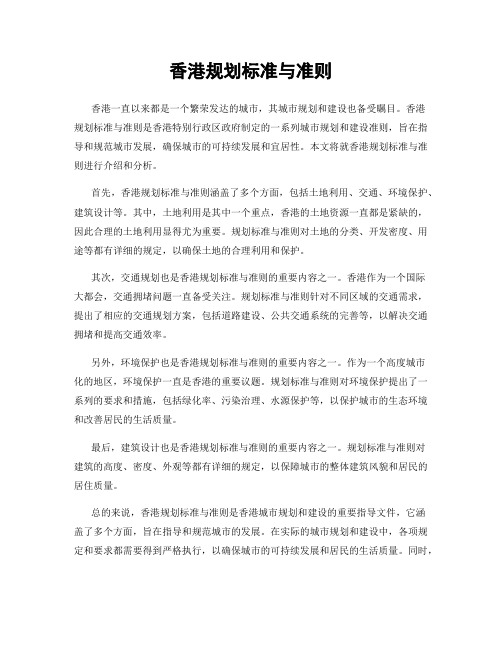
香港规划标准与准则香港一直以来都是一个繁荣发达的城市,其城市规划和建设也备受瞩目。
香港规划标准与准则是香港特别行政区政府制定的一系列城市规划和建设准则,旨在指导和规范城市发展,确保城市的可持续发展和宜居性。
本文将就香港规划标准与准则进行介绍和分析。
首先,香港规划标准与准则涵盖了多个方面,包括土地利用、交通、环境保护、建筑设计等。
其中,土地利用是其中一个重点,香港的土地资源一直都是紧缺的,因此合理的土地利用显得尤为重要。
规划标准与准则对土地的分类、开发密度、用途等都有详细的规定,以确保土地的合理利用和保护。
其次,交通规划也是香港规划标准与准则的重要内容之一。
香港作为一个国际大都会,交通拥堵问题一直备受关注。
规划标准与准则针对不同区域的交通需求,提出了相应的交通规划方案,包括道路建设、公共交通系统的完善等,以解决交通拥堵和提高交通效率。
另外,环境保护也是香港规划标准与准则的重要内容之一。
作为一个高度城市化的地区,环境保护一直是香港的重要议题。
规划标准与准则对环境保护提出了一系列的要求和措施,包括绿化率、污染治理、水源保护等,以保护城市的生态环境和改善居民的生活质量。
最后,建筑设计也是香港规划标准与准则的重要内容之一。
规划标准与准则对建筑的高度、密度、外观等都有详细的规定,以保障城市的整体建筑风貌和居民的居住质量。
总的来说,香港规划标准与准则是香港城市规划和建设的重要指导文件,它涵盖了多个方面,旨在指导和规范城市的发展。
在实际的城市规划和建设中,各项规定和要求都需要得到严格执行,以确保城市的可持续发展和居民的生活质量。
同时,随着社会的不断发展和变化,香港规划标准与准则也需要不断进行修订和完善,以适应城市发展的新需求和新挑战。
香港便览(城市规划) town_planning

香港便览城市规划城市规划的目的:城市规划的目标是透过引导和管制土地的发展和用途,以提供优质生活环境,推动经济发展,并促进社区的卫生、安全、便利和一般福祉。
城市规划循着可持续发展的原则,为市民缔造一个组织完善、高效率和称心的安居乐业之所。
香港适合用作发展的土地有限,因此在土地运用方面须力求平衡,以满足住屋、工商业、运输、康乐、自然保育、文物保护和其他社区设施等方面的需求。
城市规划组织:发展局辖下的规划地政科主管香港有关规划、土地用途、建筑物和市区重建的政策事宜。
规划署按照发展局的政策指令办事,负责在全港层面制订、监管和检讨土地用途。
规划署亦负责制定地区图则、地区改善计划和《香港规划标准与准则》,并对违例的土地用途采取行动。
城市规划委员会(城规会)是负责本港法定规划的首要组织。
城规会根据《城市规划条例》成立,由规划署提供服务,成员主要包括非官方人士,负责监察法定图则草图的拟备工作和考虑就这些草图作出的申述,以及考虑规划许可和修订图则的申请。
城规会辖下有两个常设委员会,即都会规划小组委员会和乡郊及新市镇规划小组委员会。
城规会亦可根据上述条例的规定,委任其成员组成小组委员会,以考虑就法定图则的草图作出的申述。
规划制度:本港的规划制度包括订定全港层面的发展策略,以及制订地区层面的各类法定图则和部门内部图则。
这些图则都是根据《香港规划标准与准则》、有关的发展政策、原则及公众意见拟备的。
全港发展策略:这套策略的目的,是提供概括的规划大纲,作为香港日后发展和进行策略性基础建设的指引,并为拟备地区图则提供基础。
为香港未来至2030年提供规划大纲的「香港2030:规划远景与策略」研究已完成;研究结果于2007年10月公布。
该研究采纳可持续发展为其总体目标。
建议发展策略采取三大方向,分别为提供优质生活环境、提升经济竞争力,及加强与内地的联系,以助实现香港为「亚洲国际都会」的远景。
随着香港和内地之间的经济融合及社会交流日趋紧密,当局已委托顾问定期进行跨界统计调查,以搜集有关跨界活动不同范畴的统计资料,例如旅程模式和特性,以及香港居民在内地居住的情况及意向。
香港大学城市规划part-time 博士

香港大学城市规划part-time 博士
香港大学的城市规划part-time 博士课程旨在研究全球城市与社会问题,结
合建筑、土地使用以及规划设计,分析改善城市及其所涉及方面。
课程以病及改善完善建筑以及城市规划来改善城市绿地系统为主题,以发挥建筑规划设计所带来的良性社会及环境影响,以促进全球城市可持续发展为目的。
该课程倡导研究探索深入理解城市规划与建筑的作用和影响,以及它们与城市
绿地系统的相互关系和发展。
课程涉及城市规划的基础理论及调查研究,以及社会、经济、政治环境的影响因素。
学习者将研究城市及逍遥游的定义,城市规划分析以及城市设计解决方案,以及城市建筑如何与现代社会联系起来。
此外,学习者也将探索社会,文化,技术和环境方面的挑战,其中包括性别、种族、社会不公以及财富分配问题。
总之,该课程将通过跨学科研究和实践探讨适当的规划设计,力求提升城市内
部建设发展,以及丰富城市绿地系统,改善城市的生活质量和条件,同时调节其内部的社会结构,从而带来健康,持久的可持续发展。
香港大学的城市规划part-
time 博士课程旨在实现这一目标,并期待着能够通过多元学科研究为城市改善准
备更加完善的知识和方案。
香港便览-交通
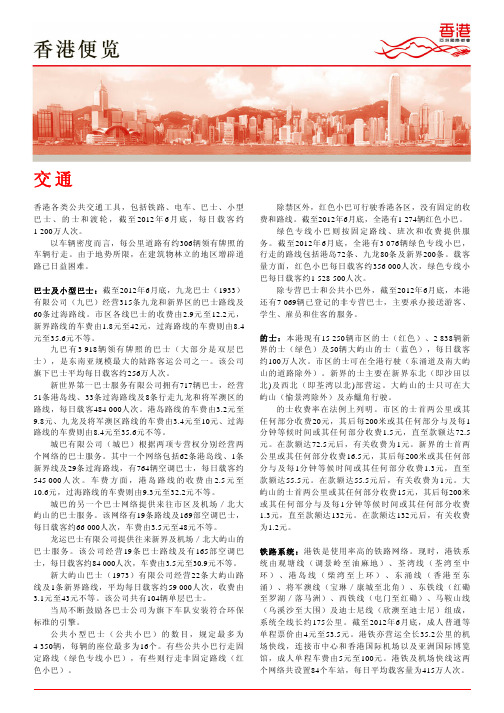
香港便览交通香港各类公共交通工具,包括铁路、电车、巴士、小型巴士、的士和渡轮,截至2012年6月底,每日载客约1 200万人次。
以车辆密度而言,每公里道路有约306辆领有牌照的车辆行走。
由于地势所限,在建筑物林立的地区增辟道路已日益困难。
巴士及小型巴士:截至2012年6月底,九龙巴士(1933)有限公司(九巴)经营315条九龙和新界区的巴士路线及60条过海路线。
市区各线巴士的收费由2.9元至12.2元,新界路线的车费由1.8元至42元,过海路线的车费则由8.4元至35.6元不等。
九巴有3 918辆领有牌照的巴士(大部分是双层巴士),是东南亚规模最大的陆路客运公司之一。
该公司旗下巴士平均每日载客约256万人次。
新世界第一巴士服务有限公司拥有717辆巴士,经营51条港岛线、33条过海路线及8条行走九龙和将军澳区的路线,每日载客484 000人次。
港岛路线的车费由3.2元至9.8元、九龙及将军澳区路线的车费由3.4元至10元、过海路线的车费则由8.4元至35.6元不等。
城巴有限公司(城巴)根据两项专营权分别经营两个网络的巴士服务。
其中一个网络包括62条港岛线、1条新界线及29条过海路线,有764辆空调巴士,每日载客约545 000人次。
车费方面,港岛路线的收费由2.5元至10.6元,过海路线的车费则由9.3元至32.2元不等。
城巴的另一个巴士网络提供来往市区及机场/北大屿山的巴士服务。
该网络有19条路线及169部空调巴士,每日载客约66 000人次,车费由3.5元至48元不等。
龙运巴士有限公司提供往来新界及机场/北大屿山的巴士服务。
该公司经营19条巴士路线及有165部空调巴士,每日载客约84 000人次,车费由3.5元至30.9元不等。
新大屿山巴士(1973)有限公司经营22条大屿山路线及1条新界路线,平均每日载客约59 000人次,收费由3.1元至43元不等。
该公司共有104辆单层巴士。
当局不断鼓励各巴士公司为旗下车队安装符合环保标准的引擎。
香港西九龙文化区规划方案文本_OMA

香港西九龙文化区规划方案文本_OMA西九龙文化区规划方案是由国际知名建筑设计事务所OMA(Officefor Metropolitan Architecture)负责的,旨在为香港西九龙地区打造一个集文化、艺术、娱乐等多功能于一体的综合性文化区域。
该规划方案旨在通过创新的设计理念和建筑形式,为香港打造一个具有国际影响力的文化与艺术中心。
以下是香港西九龙文化区规划方案的主要内容。
首先,该规划方案将通过在西九龙地区打造一座现代化的艺术馆、博物馆以及表演艺术中心,提供一个集艺术展览、教育、表演、娱乐等多功能于一体的文化交流平台。
这些文化设施将结合当代建筑风格和技术手段,为游客提供一个与众不同的艺术体验。
其次,规划方案将注重保护和发扬香港的传统文化和历史遗产。
香港西九龙文化区将修复和改造一些历史建筑,将其转变为文化场所,以吸引游客和当地居民了解香港的历史和文化。
此外,规划方案还将通过增加公共空间和绿化区域,为居民提供一个宜居的生活环境。
西九龙文化区将增加公共广场和公园,为游客和居民提供休闲、娱乐等场所,同时也为周边居民提供健身、活动等设施。
此外,规划方案还将注重可持续发展和环保。
西九龙文化区将采用绿色建筑和环保技术,减少能源消耗和环境污染,同时还将建造雨水收集系统和自然通风系统等设施,为香港打造一个可持续发展的文化区域。
总体而言,香港西九龙文化区规划方案通过创新的设计理念和建筑形式,将为香港打造一个集文化、艺术、娱乐等多功能于一体的综合性文化区域,提供给游客和居民一个与众不同的艺术体验。
该方案还注重保护和发扬香港的传统文化和历史遗产,增加公共空间和绿化区域,注重可持续发展和环保。
相信通过这一规划方案,香港将成为一个具有国际影响力的文化与艺术中心。
来港计划书模板

来港计划书模板1. 背景介绍来港计划是指计划前往香港进行学习、交流、实习或旅行的安排和准备工作。
此计划书旨在提供一个模板,以帮助申请者更好地组织和展示他们的来港计划。
2. 目的和目标来港计划的目的和目标应明确列出,以使读者可以清楚了解计划的核心目标,同时也有助于评估计划的可行性和意义。
2.1 目的来港计划的主要目的是(在此处描述计划的主要目标和意义)。
2.2 目标来港计划的具体目标是(在此处列出计划的具体目标)。
3. 计划内容在本部分中,详细描述计划的内容和安排,包括所需的时间、资源和活动。
3.1 时间安排来港计划的时间安排如下:•阶段一:准备阶段(日期)–(描述准备阶段的具体任务和活动)•阶段二:实施阶段(日期)–(描述实施阶段的具体任务和活动)•阶段三:总结和回顾阶段(日期)–(描述总结和回顾阶段的具体任务和活动)3.2 资源需求来港计划所需的资源主要包括:•(列出所需的经费、材料、设备、人力等资源,并说明如何获取)3.3 活动安排来港计划的主要活动包括但不限于以下方面:•(列出计划中的具体活动和时间安排)4. 预期成果在本部分中,描述预期的计划成果和效益。
4.1 计划成果来港计划的预期成果包括但不限于以下方面:•(列出计划中预期达到的具体成果和目标)4.2 效益来港计划的预期效益包括但不限于以下方面:•(列出计划中预期带来的具体效益和影响)5. 风险与挑战在本部分中,列出可能面临的风险和挑战,并提供应对策略。
5.1 风险可能的风险包括但不限于以下方面:•(列出可能面临的风险和障碍)5.2 应对策略针对上述风险,提供相应的应对策略,确保计划的顺利实施。
•(列出应对策略和解决方法)6. 支持与合作在本部分中,说明计划所需的支持和合作方,并提供联系信息。
6.1 支持方•(列出计划所需的支持方和合作伙伴,包括学校、机构、个人等)6.2 联系信息•(提供支持方的联系信息)7. 结束语通过以上计划书,我们希望能够清晰地传达来港计划的内容、目标和意义,并有足够的支持和合作来实现计划的顺利实施。
